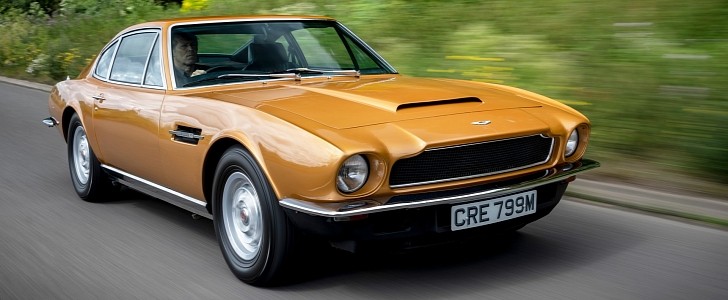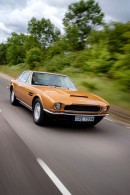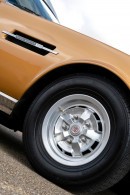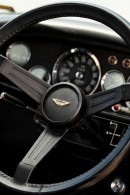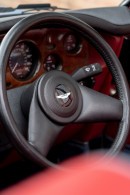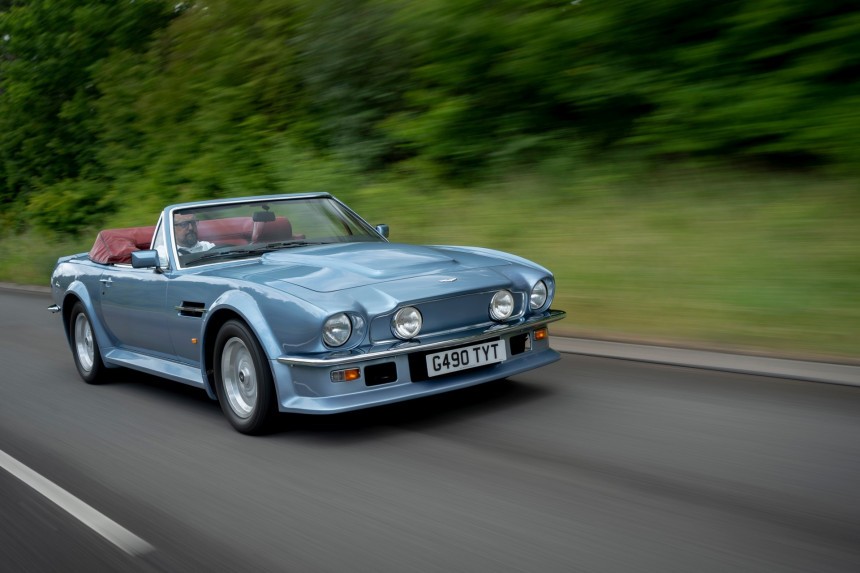Half a century ago, a great car emerged from the assembly line of Aston Martin Works – the AM V8. Inconspicuously named, the car shook off the DB nameplate of its movie star predecessors and set the pace for the next two decades of the British carmaker's production run.
While the outside of the new Aston was deceptively similar to the DBS before it, the hood hid a powerful secret weapon. A new V8 engine – the company’s first new engine in a decade – had the power to uphold the AM V8 to its super-secret agent status imbued by the “James Bond” association.
5.3 liters in displacement (323 CID) yielded a never-officially-claimed power of around 320 bhp (324 PS) and 360 lb-ft (488 Nm) of torque – according to the 2022 Aston Martin press release (read it at the bottom of the article). Quite contradictory, but when the car came out in 1972, its specs were veiled in ambiguity (for unknown reasons).
Anyway, that V8 vigor put the Aston to swift work on a 0-60 mph sprint (0-97 kph) in some six seconds, and it could hit 160 mph (257 kph) – combined with the standard ZF five-speed manual. The optional Torqueflite three-speed automatic gearbox was provided by Chrysler from across the pond.
An important note – the earliest AM V8s had a fuel injection system from Bosch. In 1973, however, carburetors replaced that – rumors have it that it was somewhat challenging to set the injection parameters correctly. Others speculate that the car had to meet the strict emissions regulations of that era.
Whatever the case, the engine modification prompted a big and visible design change – a large hood scoop that satiated the thirsty four twin-choke two-barrel Weber carbs. That feature lasted for five years. Then, in 1978, fuel injection eliminated the carburetors and their large air grabbers from the AM V8 hood.
Design-wise, the AM V8 was not remarkably different from the model it replaced, the DBS V8. Apart from the two seven-inch quartz iodine headlamps and the black mesh grille, there were virtually no visual differences between the AM V8. And that front-end apparel would go on for almost two decades, with the last Aston Martin V8 to come off the assembly line in 1989.
So delicate and blurred was the line that separated the V8 from the DBS that the first 34 AM V8s received “DBS V8” badges – leftovers from the old model. And the production figures for the hand-built Aston Martin V8 were low, even for that era: 289 models over 15 months between April 1972 and July 1973.
It would take six long years before a variant of the AM V8 would arise in the form of the 1978 Volante, which means "Flying" in Italian. That, in Aston Martin parlance, it designated the convertible version. Also, the facelift "Oscar India" came about in the same year, featuring some luxury touches not seen in Astons for almost 25 years – burr walnut trimming on the dashboard. Connolly leather and Wilton carpeting spelled "extravagance" for super-sport cars of the era.
We intentionally brought up the “supercar” term because, in 1977, the AM V8 established a bloodline of British performance with the Vantage. Fast and powerful, the Vantage quickly set a name for itself. The 380 bhp – 385 PS – and a hefty torque of 406 lb-ft (550 Nm) darted the Vantage to 170 mph (270 kph). Its zero-to-sixty score was a head-bowing 5.3 seconds (one-tenth faster than the Ferrari Daytona, the era’s yardstick in front-engined automotive greatness).
Several engine modifications complimented those achievements – bigger carbs, adequate intake manifolds, high-performance camshafts, and larger intake valves – together with a stiffer chassis and firmer suspension. Body improvements – both aesthetic and aerodynamic – accompanied the engine tune-up: the front air dam, twin driving lights inside the iconic grille, and a rear spoiler set the Vantage apart from all competition. So much so that it continued to come out of the production line for 12 years, between ’77 and ’89 – albeit in 534 examples.
The AM V8 and its derivatives were so draped in extraordinary that the automobile made a nearly two-decade-awaited comeback to the big screen as a Bond car in 1987. No wonder, as the British supercar was the fastest production four-seater in the world in its day. The perfect sidekick for the most iconic secret agent in the world.
5.3 liters in displacement (323 CID) yielded a never-officially-claimed power of around 320 bhp (324 PS) and 360 lb-ft (488 Nm) of torque – according to the 2022 Aston Martin press release (read it at the bottom of the article). Quite contradictory, but when the car came out in 1972, its specs were veiled in ambiguity (for unknown reasons).
Anyway, that V8 vigor put the Aston to swift work on a 0-60 mph sprint (0-97 kph) in some six seconds, and it could hit 160 mph (257 kph) – combined with the standard ZF five-speed manual. The optional Torqueflite three-speed automatic gearbox was provided by Chrysler from across the pond.
An important note – the earliest AM V8s had a fuel injection system from Bosch. In 1973, however, carburetors replaced that – rumors have it that it was somewhat challenging to set the injection parameters correctly. Others speculate that the car had to meet the strict emissions regulations of that era.
Design-wise, the AM V8 was not remarkably different from the model it replaced, the DBS V8. Apart from the two seven-inch quartz iodine headlamps and the black mesh grille, there were virtually no visual differences between the AM V8. And that front-end apparel would go on for almost two decades, with the last Aston Martin V8 to come off the assembly line in 1989.
So delicate and blurred was the line that separated the V8 from the DBS that the first 34 AM V8s received “DBS V8” badges – leftovers from the old model. And the production figures for the hand-built Aston Martin V8 were low, even for that era: 289 models over 15 months between April 1972 and July 1973.
It would take six long years before a variant of the AM V8 would arise in the form of the 1978 Volante, which means "Flying" in Italian. That, in Aston Martin parlance, it designated the convertible version. Also, the facelift "Oscar India" came about in the same year, featuring some luxury touches not seen in Astons for almost 25 years – burr walnut trimming on the dashboard. Connolly leather and Wilton carpeting spelled "extravagance" for super-sport cars of the era.
Several engine modifications complimented those achievements – bigger carbs, adequate intake manifolds, high-performance camshafts, and larger intake valves – together with a stiffer chassis and firmer suspension. Body improvements – both aesthetic and aerodynamic – accompanied the engine tune-up: the front air dam, twin driving lights inside the iconic grille, and a rear spoiler set the Vantage apart from all competition. So much so that it continued to come out of the production line for 12 years, between ’77 and ’89 – albeit in 534 examples.
The AM V8 and its derivatives were so draped in extraordinary that the automobile made a nearly two-decade-awaited comeback to the big screen as a Bond car in 1987. No wonder, as the British supercar was the fastest production four-seater in the world in its day. The perfect sidekick for the most iconic secret agent in the world.
